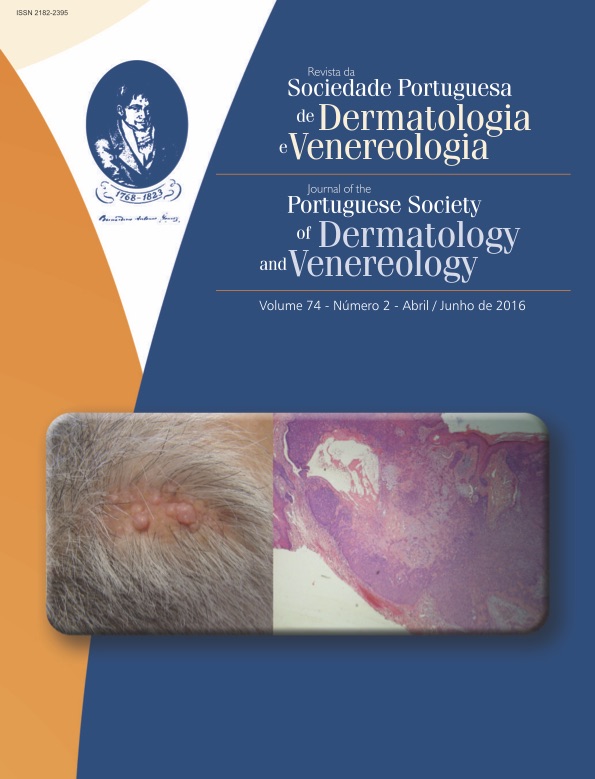Eritema Acral Bolhoso Induzido pela Gemcitabina
Resumo
O eritema acral da quimioterapia é caracterizado por áreas eritematosas e dolorosas, envolvendo predominantemente as mãos e pés, com formação de bolhas em casos severos. A gemcitabina é responsável frequentemente por reacções adversas cutâneas, embora estas sejam habitualmente transitórias e ligeiras. Relatamos o caso de um doente sob quimioterapia paliativa com gemcitabina por adenocarcinoma ductal pancreático, que desenvolveu lesões bolhosas em ambos os pés, de maiores dimensões à esquerda. A histopatologia foi consistente com eritema acral. A variante bolhosa do eritema acral da quimioterapia é uma reacção rara e, embora descrita para agentes citotóxicos estruturalmente semelhantes, não tem sido associada à gemcitabina. No doente apresentado, os antecedentes pessoais de doença arterial periférica podem ter desempenhado um papel importante na apresentação clínica final.
Downloads
Referências
Naranjo CA, Busto U, Sellers EM, Sandor P, Ruiz I, Roberts EA, et al. A method for estimating the probability of adverse drug reactions. Clin Pharmacol Ther. 1981; 30:239-45.
Rodriguez Martin AM, Guirao Arrabal E, Jimenez Puya R, Velez Garcia-Nieto A. Paraneoplastic Acral Vascular Syndrome. Actas Dermosifiliogr. 2015; 106:601-2.
Lotem M, Hubert A, Lyass O, Goldenhersh MA, Ingber A, Peretz T, et al. Skin toxic effects of polyethylene glycol-coated liposomal oxorubicin. Arch Dermatol. 2000;136:1475-80.
Bolognia JL, Cooper DL, Glusac EJ. Toxic erythema of chemotherapy: a useful clinical term. J Am Acad Dermatol. 2008; 59:524-9.
Marques Pinto G. Medicamentos que induzem ou agravam doenças cutâneas crónicas. Trab Soc Port Dermat Venereol. 2010; 68:11-44.
Revenga Arranz F, Fernandez-Duran DA, Grande C, Rodriguez Peralto JL, Vanaclocha Sebastian F. Acute and painful erythema of the hands and feet. Acral erythema induced by chemotherapy. Arch Dermatol. 1997; 133:499-500, 2-3.
Azurdia RM, Clark RE, Friedmann PS. Chemotherapy-induced acral erythema (CIAE) with bullous reaction. Cain Exp Dermatol. 1999;24:64-6.
Waltzer JF, Flowers FP. Bullous variant of chemotherapy-induced acral erythema. Arch Dermatol. 1993; 129:43-5.
Balagula Y, Lacouture ME, Cotliar JA. Dermatologic toxicities of targeted anticancer therapies. J Support Oncol. 2010; 8:149-61.
Robert C, Sibaud V, Mateus C, Cherpelis BS. Advances in the management of cutaneous toxicities of targeted therapies. Semin Oncol. 2012; 39:227-40.
Aapro MS, Martin C, Hatty S. Gemcitabine--a safety review. Anticancer Drugs. 1998; 9:191-201.
Chu CY, Yang CH, Chiu HC. Fixed erythrodysaesthesia plaque due to gemcitabine and epirubicin treatment. Acta Derm Venereol. 2002; 82:147-8.
Li J, Ko CJ, Saif MW. Recurrent cutaneous toxic erythema induced by gemcitabine in a patient with pancreatic cancer. Cutan Ocul Toxicol. 2009; 28:144-8.
Imen A, Amal K, Ines Z, Sameh el F, Fethi el M, Habib G. Bullous dermatosis associated with gemcitabine therapy for non-small-cell lung carcinoma. Respir Med. 2006;
:1463-5.
Jidar K, Ingen-Housz-Oro S, Beylot-Barry M, Paul C, Chaoui D, Sigal-Grinberg M, et al. Gemcitabine treatment in cutaneous T-cell lymphoma: a multicentre study of 23 cases. Br J Dermatol. 2009; 161:660-3.
Janusch M, Fischer M, Marsch W, Holzhausen HJ, Kegel T, Helmbold P. The hand-foot syndrome--a frequent secondary manifestation in antineoplastic chemotherapy. Eur J
Dermatol. 2006; 16:494-9.
Brandes A, Reichmann U, Plasswilm L, Bamberg M. Timeand dose-limiting erysipeloid rash confined to areas of lymphedema following treatment with gemcitabine--a report
of three cases. Anticancer Drugs. 2000; 11:15-7.
Voorburg AM, van Beek FT, Slee PH, Seldenrijk CA, Schramel FM. Vasculitis due to gemcitabine. Lung Cancer. 2002; 36:203-5.
Venat-Bouvet L, Ly K, Szelag JC, Martin J, Labourey JL, Genet D, et al. Thrombotic microangiopathy and digital necrosis: two unrecognized toxicities of gemcitabine. Anticancer Drugs. 2003; 14:829-32.
Dasanu CA. Gemcitabine: vascular toxicity and prothrombotic potential. Expert Opin Drug Saf. 2008; 7:703-16.
Scheithauer W, Blum J. Coming to grips with hand-foot syndrome. Insights from clinical trials evaluating capecitabine. Oncology. 2004; 18:1161-8, 73; discussion 73-6,81-4.
Kanai M, Matsumoto S, Nishimura T, Matsumura Y, Hatano E, Mori A, et al. Premedication with 20 mg dexamethasone effectively prevents relapse of extensive skin rash associated with gemcitabine monotherapy. Ann Oncol. 2010; 21:189-90.
Todos os artigos desta revista são de acesso aberto sob a licença internacional Creative Commons Attribution-NonCommercial 4.0 (CC BY-NC 4.0).








